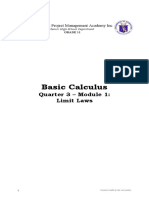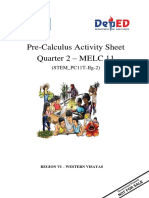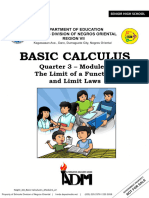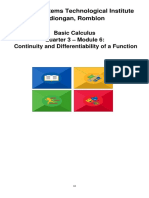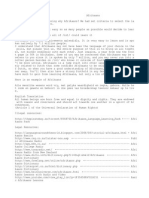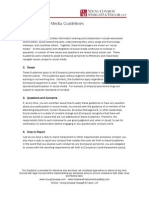Module Basic Calculus Module 1 Updated
Uploaded by
Monria FernandoModule Basic Calculus Module 1 Updated
Uploaded by
Monria FernandoThe Maquiling School, Inc.
Senior High School Department
College, Los Bańos Laguna
BASIC CALCULUS
2nd Semester SY 2020-2021
MODULE 1: Limits and Continuity
Name: _____________________________________ LRN: __________________________
Grade Level: ____________ Strand: _____________ Class Code: ____________________
MODULE 1: Limits and Continuity
UNIT 1.1
Limit of a Function
The main focus of Calculus is to study haw things change. Real-life situations can be modeled using functions.
Calculus provides a way to investigate the effects of these situations which deal with change. This involves
differentiation and integration. The main tool in studying the derivatives is the concept of limits.
Suppose we want to graph the function f(x)=2x+1. We use a table of values and include the intercepts, if there
are any, in the table. We illustrate the table below
x -6 -3 -1 -0.5 0 0.5 1 4 5
f(x) -11 -5 -1 0 1 2 3 9 11
This function is linear and has slope 2. The graph is shown below
Now consider the function . If we factor the numerator, we obtain
What happens to the y-values as the x-values get closer to ?
What is the difference between the graphs of the functions and ?
x 4 4.1 4.5 4.9 4.999 4.99999 5 5.00001 5.01 5.1 5.5 6
2x+1, x
9 9.2 10 10.8 10.998 10.99998 undefined 11.00002 11.02 11.2 12 13
is not 5
As the x-values approaches 5 from both directions, the y-values approaches 11. The points approach (5, 11)
but the point is not defined.
Definition:
Let f(x) be defined for all other x in some open interval I containing x. The function f(x) may or may not be
defined at x=c. The limit of f(x) as x approaches c is equal to the number L, written as
If we can make the values of f(x) arbitrarily close to L by taking x values sufficiently close to c, on either side of
x=c, but not equal to c.
Maquiling School Inc. | Gonzales, WA Page 2
Left-hand limit: ( means x approaches c from the left)
Right-hand limit: ( means x approaches c from the right)
Now, exists if and only if
If the left-hand limit and the right hand limit are not the same, then the limit does not exist.
Example:
Consider the function . Let c=2.
The graph of this function shows that coming from the left and the right, the values of y as x approaches to 2 is
both 8. Hence,
Consider the piecewise function ,
Take note that the value is defined at x=-1.
The question is, does the limit exist at x=-1?
We get the following limits:
Since , then the limit does not exist.
UNIT 1.2
The Limit Theorem
It is not easy to evaluate the limit of the function from the graph or the table of values.
Limit Theorem
Suppose that c is a real number and that and both exist.
1. Limit of the identity function
2. Constant Rule
3. Sum Rule: The limit of the sum of two functions is the sum of their limits.
4. Difference Rule: The limit of the difference of two functions is the difference of their limits.
5. Product Rule: The limit of the product of two functions is the product of their limits.
Maquiling School Inc. | Gonzales, WA Page 3
6. Product of a constant and a function: The constant k can be factored outside the limit.
7. Quotient Rule: The limit of the quotient of two functions is the quotient of their limits, except if the limit of
the denominator is zero.
8. Power Rule: The limit of the sum of two functions is the sum of their limits.
9. Power Function Rule: The limit of an nth power of a function is the nth power of the limit of the function,
where n is a positive integer.
* +
10. Radical Rule:
√ √
11. Radical Function Rule: The limit of an nth root of a function is the nth root of the limit of the function,
where n is a positive integer, and if n is even.
√ √
12. Direct Substitution Property: If f(x) is a polynomial or a rational function and c is in the domain of f, then
13. Rational Power Rule: Let m and n be integers with no common factor and n is not zero.
* +
Some Examples:
Using Limit Theorem 1
Using Limit Theorem 2
Using Limit Theorem 3
Using Limit Theorem 1 and 2
√ √ Using Limit Theorem 4
√ Using Limit Theorem 1 and 2
Indeterminate Form 0/0
If and , then is called an indeterminate form 0/0.
If we get an indeterminate form 0/0, we need to write the numerator and denominator so we can obtain a
new form. We could employ techniques such as factoring or multiplying with conjugates or finding the LCD.
UNIT 1.3
Infinite Limits and Limits at Infinity
Consider , where x is not zero. We want to determine the behavior of the y-values as the values of x
become very close to 0 through positive real numbers and through negative real numbers.
We denote this as the one-sided limits, one approaching from the right and the other from the left:
and
Let us make a table of values where we choose x values very close to 0.
Maquiling School Inc. | Gonzales, WA Page 4
x -0.0001 -0.001 -0.01 -0.1 0.0001 0.001 0.01 0.1
F(x)=1/x -10 000 -1 000 -100 -10 10 000 1 000 100 10
As x approaches 0 from the right, the y-values become very large and increase without bound.
As x approaches 0 from the left, the y-values decrease without bound. Therefore we write,
Infinite Limit Theorem 1
Let n be any positive integer. Then,
{
Infinite Limit Theorem 2
Let c be any real number. Suppose in * +, and , where k is a real
number.
a. If and through positive values, then * +
b. If and through negative values, then * +
c. If and through positive values, then * +
d. If and through negative values, then * +
Maquiling School Inc. | Gonzales, WA Page 5
UNIT 1.3b
Infinite Limits and Limits at Infinity
Suppose we want to determine the behavior of y=f(x) as the x-values increase without bound (x approaches
+ ) and as the x-values decrease without bound (x approaches - ). We again consider y=f(x)=1/x. We want to
find the limit of 1/x as and as . We then construct the table of values where we chose x-values
that approach positive infinity and negative infinity.
x -100 000 -10 000 -1 000 -100 100 1 000 10 000 100 000
F(x)=1/x -0.00001 -0.0001 -0.001 -0.01 0.01 0.001 0.0001 0.00001
We note that the values of 1/x get very close to zero as the x-values approach positive infinity and
negative infinity. We write this limit notation as
We refer to these limits as limits at infinity.
Limit at Infinity Theorem 1
Let r be any positive integer. Then,
a.
b.
Limit at Infinity Theorem 2
Let n be a positive real number and k, any real number except zero. Then,
a.
b.
c. {
d. {
Limit at Infinity Theorem 3
Let where f(x) and g(x) are polynomials.
a. If the degree of f(x) is less than the degree of g(x), then
b. If the degree of f(x) is equal to the degree of g(x), and a is the leading coefficient of f(x) and b
is the leading coefficient of g(x), then
c. If the degree of f(x) is greater than the degree of g(x), then
Maquiling School Inc. | Gonzales, WA Page 6
Examples:
Find the limit.
a. By limit at Infinity Theorem 1a, the limit is 0.
b. By limit at Infinity Theorem 2a, the limit is 0.
c. By limit at Infinity Theorem 2c, the limit is .
d. By limit at Infinity Theorem 2d, the limit is .
e. We factor out the highest-degree term from the numerator and the
denominator. Then apply Limit Theorems and Limit at Infinity.
( )
( )
Since , , and
UNIT 1.4
Limits of Trigonometric, Exponential, and Logarithmic Functions
Limit Theorems of Trigonometric Functions
Let c be a real number in the domain of the given function. Then,
1.
2.
3.
4.
5.
6.
Other Trigonometric Limit Theorems
7.
8.
9.
Examples:
Evaluate
Solution: We use the Direct Substitution property to obtain
Maquiling School Inc. | Gonzales, WA Page 7
Examples:
Evaluate .
Solution: We apply the Limit Theorems particularly the direct Substitution property to get
( ) ( )
(√ )
Examples:
Evaluate .
Solution: We multiply and divide the numerator by 2x and multiply and divide the denominator by 7x,
to obtain
( )
( )
By Trigonometric Limit Theorem 7, and
Limit Laws of Exponential and Logarithmic Functions
1. If b>1, then
2. If 0<b<1, then
3. If b>1, then
4. If b>1, then
We can extend these limits when the base is the number e. Since e>1, then
5.
6.
We now state the limit definitions for the number
1.
2.
3. ( )
Reference:
Domingo (2016). “Limits and Continuity”. Math Activated: Engage Yourself and Our World, Basic Calculus,
Salesiana Books by Don Bosco Press Inc. pp.4-58
Maquiling School Inc. | Gonzales, WA Page 8
Student Name: Score:
Date:
Exercise 1.1
A. Consider the piecewise function { , determine the following:
Does exists?
Exercise 1.2
A. Evaluate the limits
1.
2.
3.
4.
5. √
Maquiling School Inc. | Gonzales, WA Page 9
Exercise 1.3
A. Evaluate
B. Evaluate
C. Evaluate
Maquiling School Inc. | Gonzales, WA Page 10
Exercise 1.3b
A. Evaluate the following limits at infinity.
a. Evaluate
b. Evaluate
c. Evaluate
d. Evaluate
e. Evaluate
Maquiling School Inc. | Gonzales, WA Page 11
Exercise 1.4
A. Evaluate the following limits for trigonometric functions.
a. Evaluate
b. Evaluate
c. Evaluate
d. Evaluate
e. Evaluate
Maquiling School Inc. | Gonzales, WA Page 12
You might also like
- NEWS2 Chart 3 - NEWS Observation Chart - 0 PDFNo ratings yetNEWS2 Chart 3 - NEWS Observation Chart - 0 PDF1 page
- Pre-Calculus Learning Activity Sheet Quarter 2 - Melc 1: (Stem - Pc11T-Iia-1)No ratings yetPre-Calculus Learning Activity Sheet Quarter 2 - Melc 1: (Stem - Pc11T-Iia-1)7 pages
- Basic Calculus Activity Sheet Quarter 3 - Melc 5No ratings yetBasic Calculus Activity Sheet Quarter 3 - Melc 510 pages
- Specialized Stem-11 Basic-Calculus Q4 Clas2No ratings yetSpecialized Stem-11 Basic-Calculus Q4 Clas213 pages
- Basic Calculus: Quarter 3 - Module 1: Limit LawsNo ratings yetBasic Calculus: Quarter 3 - Module 1: Limit Laws9 pages
- AIR Basic Calculus Q3 W3 - Module 3 Continuity of A Function 2No ratings yetAIR Basic Calculus Q3 W3 - Module 3 Continuity of A Function 225 pages
- Basic Calculus Activity Sheet Quarter 3 - Melc 433% (3)Basic Calculus Activity Sheet Quarter 3 - Melc 47 pages
- Pre-Calculus Learning Activity Sheet Quarter 2 - Melc 4: (Stem - Pc11T-Iib-1)No ratings yetPre-Calculus Learning Activity Sheet Quarter 2 - Melc 4: (Stem - Pc11T-Iib-1)7 pages
- Basic Calculus: Quarter 3 - Module 5 Rules of DifferentiationNo ratings yetBasic Calculus: Quarter 3 - Module 5 Rules of Differentiation28 pages
- Lesson 1 - The Limit of A Function - Theorems and ExamplesNo ratings yetLesson 1 - The Limit of A Function - Theorems and Examples65 pages
- G11 - Q3 - LAS - Week1 - L1.2-1.3 - Basic CalculusNo ratings yetG11 - Q3 - LAS - Week1 - L1.2-1.3 - Basic Calculus16 pages
- Pre-Calculus Activity Sheet Quarter 2 - Melc 7: (Stem - Pc11T-Iic-D-1)No ratings yetPre-Calculus Activity Sheet Quarter 2 - Melc 7: (Stem - Pc11T-Iic-D-1)16 pages
- Basiccalculus q3 Mod12 Relatedratesproblems FinalNo ratings yetBasiccalculus q3 Mod12 Relatedratesproblems Final20 pages
- Pre-Calculus Activity Sheet Quarter 2 - Melc 11: (Stem - Pc11T-Iig-2)100% (1)Pre-Calculus Activity Sheet Quarter 2 - Melc 11: (Stem - Pc11T-Iig-2)9 pages
- Learner'S Activity Sheets (Las) : ObjectiveNo ratings yetLearner'S Activity Sheets (Las) : Objective5 pages
- Basic Calculus: Quarter 3 - Module 4: Continuity of A Function100% (1)Basic Calculus: Quarter 3 - Module 4: Continuity of A Function22 pages
- Basiccalculus q3 Mod11 Implicitdifferentiation Final100% (1)Basiccalculus q3 Mod11 Implicitdifferentiation Final25 pages
- Grade 11 Basic Calculus: Quarter 3 - Week 5 Module100% (1)Grade 11 Basic Calculus: Quarter 3 - Week 5 Module9 pages
- Module in Pre Calculus Grade 11 Second Quarter, Week 6 To Week 8No ratings yetModule in Pre Calculus Grade 11 Second Quarter, Week 6 To Week 826 pages
- G11 - General Mathematics - 1st Sem - Midterm NotesNo ratings yetG11 - General Mathematics - 1st Sem - Midterm Notes5 pages
- Quarter 3/week # 1 Part 2: Learning Activity Sheet (SHS) Basic CalculusNo ratings yetQuarter 3/week # 1 Part 2: Learning Activity Sheet (SHS) Basic Calculus12 pages
- Basic Calculus: Quarter 3 - Module 1.3 Illustrate The Limit LawsNo ratings yetBasic Calculus: Quarter 3 - Module 1.3 Illustrate The Limit Laws16 pages
- Pre-Calculus Activity Sheet Quarter 2 - Melc 9: (Stem - Pc11T-Iie-1)No ratings yetPre-Calculus Activity Sheet Quarter 2 - Melc 9: (Stem - Pc11T-Iie-1)7 pages
- B BASIC CALCULUS 11 Q3W1.2 Learner Copy Final LayoutNo ratings yetB BASIC CALCULUS 11 Q3W1.2 Learner Copy Final Layout13 pages
- Lesson 1.2 - 1.3 - Evaluating Functions & Operations On FunctionsNo ratings yetLesson 1.2 - 1.3 - Evaluating Functions & Operations On Functions16 pages
- POINTERS TO REVIEW IN PRECALCULUS Quarter 2No ratings yetPOINTERS TO REVIEW IN PRECALCULUS Quarter 23 pages
- Basic Calculus: Antiderivatives of Exponential & Logarithmic FunctionsNo ratings yetBasic Calculus: Antiderivatives of Exponential & Logarithmic Functions9 pages
- Lesson 1: Understanding Culture, Society, & Politics: Some Key ObservationsNo ratings yetLesson 1: Understanding Culture, Society, & Politics: Some Key Observations14 pages
- Personality Development: The Maquiling School, IncNo ratings yetPersonality Development: The Maquiling School, Inc4 pages
- Kinshipmarriageandthehousehold 170907030015No ratings yetKinshipmarriageandthehousehold 17090703001535 pages
- Barriers To Physical Activity Participation Among Adults An End of Obstetrics and Gynaecology/Health Promotion Posting Presentation BY Ayodele, Ayobami EmmanuelNo ratings yetBarriers To Physical Activity Participation Among Adults An End of Obstetrics and Gynaecology/Health Promotion Posting Presentation BY Ayodele, Ayobami Emmanuel22 pages
- Barriers To Physical Activity Participation Among Adults An End of Obstetrics and Gynaecology/Health Promotion Posting Presentation BY Ayodele, Ayobami EmmanuelNo ratings yetBarriers To Physical Activity Participation Among Adults An End of Obstetrics and Gynaecology/Health Promotion Posting Presentation BY Ayodele, Ayobami Emmanuel22 pages
- Values Education 7: The Maquiling School, IncNo ratings yetValues Education 7: The Maquiling School, Inc8 pages
- FITT Principle & Muscular Strength Workout PlanNo ratings yetFITT Principle & Muscular Strength Workout Plan13 pages
- Physical Education and Health 12: Part 3: DanceNo ratings yetPhysical Education and Health 12: Part 3: Dance33 pages
- Values Education 10: The Maquiling School, Inc100% (1)Values Education 10: The Maquiling School, Inc6 pages
- Coduri de Defect: Combustibil (EKPS (Fuel Pump Control) - Diagnose)No ratings yetCoduri de Defect: Combustibil (EKPS (Fuel Pump Control) - Diagnose)4 pages
- What Is Cardiac Axis ECG Interpretation Geeky MedicsNo ratings yetWhat Is Cardiac Axis ECG Interpretation Geeky Medics1 page
- Maratha Mandir Babasaheb Gawade Institution of Management Studies Mms Semester Ii Subject - Analysis of Financial StatementNo ratings yetMaratha Mandir Babasaheb Gawade Institution of Management Studies Mms Semester Ii Subject - Analysis of Financial Statement9 pages
- Quantitative Aptitude Sample Paper 1 PDFNo ratings yetQuantitative Aptitude Sample Paper 1 PDF9 pages
- Automatic Transmission / Trans: - Automatic Transaxle Assy (U250E)No ratings yetAutomatic Transmission / Trans: - Automatic Transaxle Assy (U250E)2 pages
- Sample Social Media Policy For EmployersNo ratings yetSample Social Media Policy For Employers3 pages
- National Comprehensive HIV Prevention, Care, and Treatment Training For Pharmacy Professionals-Participant ManualNo ratings yetNational Comprehensive HIV Prevention, Care, and Treatment Training For Pharmacy Professionals-Participant Manual326 pages
- Ashok Raj Khati: Key Word: English As A Global Language, Local Language, EFL (English As ForeignNo ratings yetAshok Raj Khati: Key Word: English As A Global Language, Local Language, EFL (English As Foreign15 pages
- Rethinking Resistance: (S. Ramnarayan and Christian Harpelund)100% (1)Rethinking Resistance: (S. Ramnarayan and Christian Harpelund)12 pages
- 49 Illegal Operating TV Stations To Be Shut Down Final 2100% (1)49 Illegal Operating TV Stations To Be Shut Down Final 22 pages
- Brake Master Cylinder - Expansion Tank BMW E60 Sedan 47750No ratings yetBrake Master Cylinder - Expansion Tank BMW E60 Sedan 477502 pages
- Test Bank for Refrigeration and Air Conditioning Technology, 9th Edition, Eugene Silberstein, Jason Obrzut, John Tomczyk, Bill Whitman, Bill Johnson - Available For One-Click Instant Download100% (3)Test Bank for Refrigeration and Air Conditioning Technology, 9th Edition, Eugene Silberstein, Jason Obrzut, John Tomczyk, Bill Whitman, Bill Johnson - Available For One-Click Instant Download46 pages
- Cryptographic Algorithm Validation ProgramNo ratings yetCryptographic Algorithm Validation Program21 pages
- (Hong 2011) Theoretical modeling for a rotor-bearing-foundation system and its dynamic characteristiNo ratings yet(Hong 2011) Theoretical modeling for a rotor-bearing-foundation system and its dynamic characteristi12 pages
- Pre-Calculus Learning Activity Sheet Quarter 2 - Melc 1: (Stem - Pc11T-Iia-1)Pre-Calculus Learning Activity Sheet Quarter 2 - Melc 1: (Stem - Pc11T-Iia-1)
- AIR Basic Calculus Q3 W3 - Module 3 Continuity of A Function 2AIR Basic Calculus Q3 W3 - Module 3 Continuity of A Function 2
- Pre-Calculus Learning Activity Sheet Quarter 2 - Melc 4: (Stem - Pc11T-Iib-1)Pre-Calculus Learning Activity Sheet Quarter 2 - Melc 4: (Stem - Pc11T-Iib-1)
- Basic Calculus: Quarter 3 - Module 5 Rules of DifferentiationBasic Calculus: Quarter 3 - Module 5 Rules of Differentiation
- Lesson 1 - The Limit of A Function - Theorems and ExamplesLesson 1 - The Limit of A Function - Theorems and Examples
- G11 - Q3 - LAS - Week1 - L1.2-1.3 - Basic CalculusG11 - Q3 - LAS - Week1 - L1.2-1.3 - Basic Calculus
- Pre-Calculus Activity Sheet Quarter 2 - Melc 7: (Stem - Pc11T-Iic-D-1)Pre-Calculus Activity Sheet Quarter 2 - Melc 7: (Stem - Pc11T-Iic-D-1)
- Pre-Calculus Activity Sheet Quarter 2 - Melc 11: (Stem - Pc11T-Iig-2)Pre-Calculus Activity Sheet Quarter 2 - Melc 11: (Stem - Pc11T-Iig-2)
- Basic Calculus: Quarter 3 - Module 4: Continuity of A FunctionBasic Calculus: Quarter 3 - Module 4: Continuity of A Function
- Basiccalculus q3 Mod11 Implicitdifferentiation FinalBasiccalculus q3 Mod11 Implicitdifferentiation Final
- Grade 11 Basic Calculus: Quarter 3 - Week 5 ModuleGrade 11 Basic Calculus: Quarter 3 - Week 5 Module
- Module in Pre Calculus Grade 11 Second Quarter, Week 6 To Week 8Module in Pre Calculus Grade 11 Second Quarter, Week 6 To Week 8
- G11 - General Mathematics - 1st Sem - Midterm NotesG11 - General Mathematics - 1st Sem - Midterm Notes
- Quarter 3/week # 1 Part 2: Learning Activity Sheet (SHS) Basic CalculusQuarter 3/week # 1 Part 2: Learning Activity Sheet (SHS) Basic Calculus
- Basic Calculus: Quarter 3 - Module 1.3 Illustrate The Limit LawsBasic Calculus: Quarter 3 - Module 1.3 Illustrate The Limit Laws
- Pre-Calculus Activity Sheet Quarter 2 - Melc 9: (Stem - Pc11T-Iie-1)Pre-Calculus Activity Sheet Quarter 2 - Melc 9: (Stem - Pc11T-Iie-1)
- B BASIC CALCULUS 11 Q3W1.2 Learner Copy Final LayoutB BASIC CALCULUS 11 Q3W1.2 Learner Copy Final Layout
- Lesson 1.2 - 1.3 - Evaluating Functions & Operations On FunctionsLesson 1.2 - 1.3 - Evaluating Functions & Operations On Functions
- Basic Calculus: Antiderivatives of Exponential & Logarithmic FunctionsBasic Calculus: Antiderivatives of Exponential & Logarithmic Functions
- Lesson 1: Understanding Culture, Society, & Politics: Some Key ObservationsLesson 1: Understanding Culture, Society, & Politics: Some Key Observations
- Personality Development: The Maquiling School, IncPersonality Development: The Maquiling School, Inc
- Barriers To Physical Activity Participation Among Adults An End of Obstetrics and Gynaecology/Health Promotion Posting Presentation BY Ayodele, Ayobami EmmanuelBarriers To Physical Activity Participation Among Adults An End of Obstetrics and Gynaecology/Health Promotion Posting Presentation BY Ayodele, Ayobami Emmanuel
- Barriers To Physical Activity Participation Among Adults An End of Obstetrics and Gynaecology/Health Promotion Posting Presentation BY Ayodele, Ayobami EmmanuelBarriers To Physical Activity Participation Among Adults An End of Obstetrics and Gynaecology/Health Promotion Posting Presentation BY Ayodele, Ayobami Emmanuel
- Coduri de Defect: Combustibil (EKPS (Fuel Pump Control) - Diagnose)Coduri de Defect: Combustibil (EKPS (Fuel Pump Control) - Diagnose)
- What Is Cardiac Axis ECG Interpretation Geeky MedicsWhat Is Cardiac Axis ECG Interpretation Geeky Medics
- Maratha Mandir Babasaheb Gawade Institution of Management Studies Mms Semester Ii Subject - Analysis of Financial StatementMaratha Mandir Babasaheb Gawade Institution of Management Studies Mms Semester Ii Subject - Analysis of Financial Statement
- Automatic Transmission / Trans: - Automatic Transaxle Assy (U250E)Automatic Transmission / Trans: - Automatic Transaxle Assy (U250E)
- National Comprehensive HIV Prevention, Care, and Treatment Training For Pharmacy Professionals-Participant ManualNational Comprehensive HIV Prevention, Care, and Treatment Training For Pharmacy Professionals-Participant Manual
- Ashok Raj Khati: Key Word: English As A Global Language, Local Language, EFL (English As ForeignAshok Raj Khati: Key Word: English As A Global Language, Local Language, EFL (English As Foreign
- Rethinking Resistance: (S. Ramnarayan and Christian Harpelund)Rethinking Resistance: (S. Ramnarayan and Christian Harpelund)
- 49 Illegal Operating TV Stations To Be Shut Down Final 249 Illegal Operating TV Stations To Be Shut Down Final 2
- Brake Master Cylinder - Expansion Tank BMW E60 Sedan 47750Brake Master Cylinder - Expansion Tank BMW E60 Sedan 47750
- Test Bank for Refrigeration and Air Conditioning Technology, 9th Edition, Eugene Silberstein, Jason Obrzut, John Tomczyk, Bill Whitman, Bill Johnson - Available For One-Click Instant DownloadTest Bank for Refrigeration and Air Conditioning Technology, 9th Edition, Eugene Silberstein, Jason Obrzut, John Tomczyk, Bill Whitman, Bill Johnson - Available For One-Click Instant Download
- (Hong 2011) Theoretical modeling for a rotor-bearing-foundation system and its dynamic characteristi(Hong 2011) Theoretical modeling for a rotor-bearing-foundation system and its dynamic characteristi








